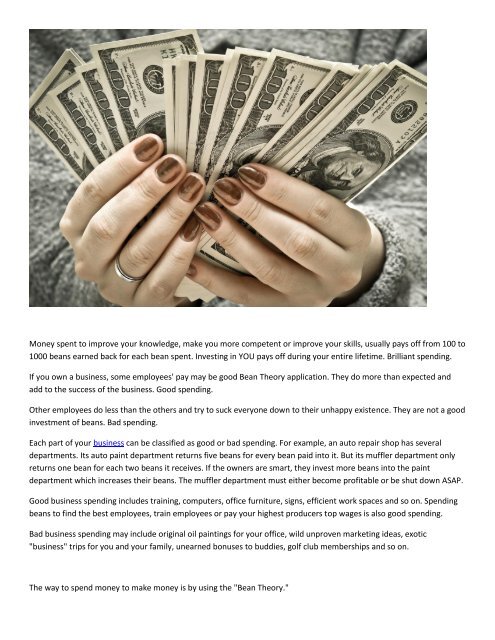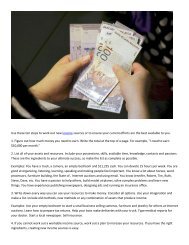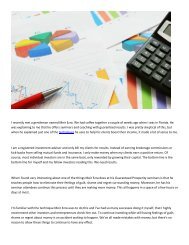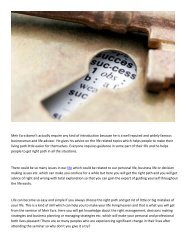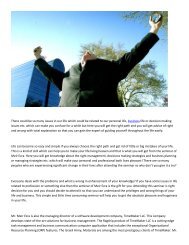Meir Ezra: How to spend money to make more money
Businesses that spend money intelligently make more profit. Their employees earn higher salaries and their customers get better service. Businesses that spend money foolishly cannot afford top employees who produce high-quality services or products.
Businesses that spend money intelligently make more profit. Their employees earn higher salaries and their customers get better service. Businesses that spend money foolishly cannot afford top employees who produce high-quality services or products.
- TAGS
- meir-ezra
Create successful ePaper yourself
Turn your PDF publications into a flip-book with our unique Google optimized e-Paper software.
Money spent <strong>to</strong> improve your knowledge, <strong>make</strong> you <strong>more</strong> competent or improve your skills, usually pays off from 100 <strong>to</strong><br />
1000 beans earned back for each bean spent. Investing in YOU pays off during your entire lifetime. Brilliant <strong>spend</strong>ing.<br />
If you own a business, some employees' pay may be good Bean Theory application. They do <strong>more</strong> than expected and<br />
add <strong>to</strong> the success of the business. Good <strong>spend</strong>ing.<br />
Other employees do less than the others and try <strong>to</strong> suck everyone down <strong>to</strong> their unhappy existence. They are not a good<br />
investment of beans. Bad <strong>spend</strong>ing.<br />
Each part of your business can be classified as good or bad <strong>spend</strong>ing. For example, an au<strong>to</strong> repair shop has several<br />
departments. Its au<strong>to</strong> paint department returns five beans for every bean paid in<strong>to</strong> it. But its muffler department only<br />
returns one bean for each two beans it receives. If the owners are smart, they invest <strong>more</strong> beans in<strong>to</strong> the paint<br />
department which increases their beans. The muffler department must either become profitable or be shut down ASAP.<br />
Good business <strong>spend</strong>ing includes training, computers, office furniture, signs, efficient work spaces and so on. Spending<br />
beans <strong>to</strong> find the best employees, train employees or pay your highest producers <strong>to</strong>p wages is also good <strong>spend</strong>ing.<br />
Bad business <strong>spend</strong>ing may include original oil paintings for your office, wild unproven marketing ideas, exotic<br />
"business" trips for you and your family, unearned bonuses <strong>to</strong> buddies, golf club memberships and so on.<br />
The way <strong>to</strong> <strong>spend</strong> <strong>money</strong> <strong>to</strong> <strong>make</strong> <strong>money</strong> is by using the "Bean Theory."
"Finance is best unders<strong>to</strong>od as a COMMODITY* in terms of beans." "So many beans issued <strong>to</strong> an activity and so many<br />
<strong>more</strong> beans back."<br />
-- L. Ron Hubbard (*Commodity: An item that is bought, sold or traded.)<br />
Bean Theory Examples<br />
Example #1: You buy a $2500 stereo system with a credit card. The stereo system <strong>make</strong>s you no <strong>money</strong> and loses value<br />
over time. You pay $2000 in interest over five years before you pay off the credit card debt. For 4500 beans paid out,<br />
you get no beans back and have an asset worth 1200 beans or less. Bad <strong>spend</strong>ing.<br />
Example #2: You buy a small old house. You pay $25,000 as a down payment and a home loan for $75,000. You invest<br />
$25,000 in upgrades and repairs. Over three years, you pay $13,000 in interest. You then sell the house for $160,000.<br />
For 25,000 beans for the down payment, 25,000 in repairs and 13,000 beans in loan interest, you get 22,000 beans after<br />
the loan is paid off. You also lived in the house for three years which saved you 12,000 beans in rent per year. Total<br />
profit of 58,000 beans. Good <strong>spend</strong>ing.<br />
Example #3: You <strong>spend</strong> $500 <strong>to</strong> learn how <strong>to</strong> create websites. You enjoy the work and create some brilliant examples.<br />
Your friends ask you <strong>to</strong> help them and through word-of-mouth, you are soon earning an extra $2000 per month. Your<br />
500 beans return thousands of beans back <strong>to</strong> you.


